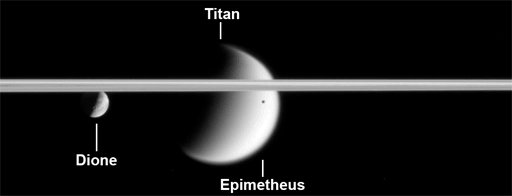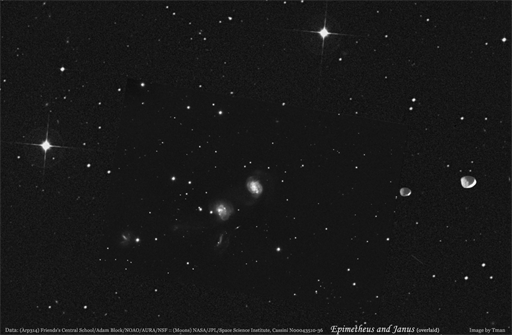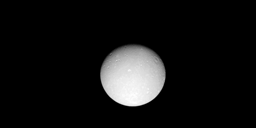Emily Lakdawalla • Sep 04, 2009
Happy Saturn ring plane crossing day!
Since Saturn's equinox on August 11, Earth has been in an unusual position, on the night side of Saturn's rings. Today, though, we move back to the sunlit side as Earth crosses through Saturn's ring plane. This would be an interesting time to take photos of Saturn except for one small problem: Saturn's almost at solar conjunction (that event happens on the 17th), so it's way too close to the Sun for photography right now.
I wrote much more about this for today's episode of 365 Days of Astronomy; I'll post the transcript of that show below. One of the things I discuss in this show is "mutual events," when an observer manages to catch a view of one body in space passing across another. Here are a bunch of nifty animations of mutual events captured by Cassini over the past few years:

NASA / JPL / SSI / Emily Lakdawalla
Mutual event of Titan, Epimetheus, and Dione, plus Pandora and Saturn
This animation represents 29 frames captured by Cassini on January 5, 2006 and shows Epimetheus passing in front of Titan and Dione, below Saturn's rings. A faint star also pops into view during the animation, and at the end, Pandora is visible in front of the rings and the disk of Saturn. I wrote an extended blog entry on this animation.
Data: NASA / JPL / SSI / KPNO / NOAO / Peter Greutmann
Janus and Epimetheus 'mutual event' against a star field
On November 29, 2005, Cassini captured a "mutual event" animation of Janus and Epimetheus. Janus and Epimetheus do not actually pass each other in their orbits; it is Cassini's motion that makes them appear to. Several background stars were visible in the raw images, so amateur Peter Greutmann cut Janus and Epimetheus from the Cassini raw images and superimposed them on an accurately scaled and oriented image of the correct star field from an NOAO telescope. Here's a news story I wrote on the orbital dance of Janus and Epimetheus.
NASA / JPL / SSI
Mutual event of Enceladus, Rhea, and Mimas
Cassini had the rare opportunity to witness a "mutual event" of three of Saturn's large moons at the same time on January 27, 2006.
NASA / JPL / SSI / color and animation by Gordan Ugarkovic
Titan, Dione, and Saturn
When enlarged to full size, this animation is composed of sixteen wide-angle frames captured by Cassini on July 29, 2007. The images were taken through a filter in a methane "window," so details in Saturn's clouds and on Titan's surface that are usually obscured by methane haze are visible. Each image has been colorized based upon other natural-color Cassini images. Titan transits Saturn from left to right as much smaller, brighter Dione moves from right to left at the extreme right edge of this image. Titan's rings are seen edge-on so are almost invisible. The rings cast broad black shadows on Saturn's northern hemisphere. The full-size version is best viewed as a Quicktime movie (264k).Hi, I'm Emily Lakdawalla, blogger for The Planetary Society at planetary dot org slash blog. Today, September four, twenty oh nine, is the day that Earth passes through the plane of Saturn's rings. Ring plane crossings like these are priceless events for planetary astronomers. In today's podcast I'll touch on the discoveries we've made during past ring plane crossings, and explain why this one will, sadly, turn out to be a bit of a dud.
The solar system is a playground for lovers of geometry. Slicing up the solar system are numerous planes containing the orbits of every body that circles the Sun. All of these planes intersect at the Sun, but other than that they're not constrained, and no two bodies have perfectly coinciding orbital planes. However, because of the way that the solar system first formed from a spinning disk of material, most of the planets' orbital planes are quite close to each other, which is why the planets appear to travel through the same arc in our night sky, the ecliptic.
Of course, every planet with moons is a mini-solar system unto itself. Most planets' big moons and rings orbit in the planet's equatorial plane. Conservation of angular momentum dictates that the orientation of a planet's equatorial plane doesn't change as the planet moves around the Sun. So sometimes a planet's equatorial plane tilts toward the Sun, and sometimes it tilts away, but twice an orbit, the equatorial plane sweeps across the Sun. This is called the equinox and it marks the changing of the seasons; at an equinox, spring arrives to a formerly shadowed pole, and autumn darkens the formerly lit pole.
Earth's orbital motion can also carry it through the plane of a giant planet's rings. Because Jupiter, Saturn, Uranus, and Neptune are so much farther from the Sun than Earth is, Earth is always pretty close to the Sun from those outer planets' point of view. So Earth typically crosses through the planets' equatorial planes on dates very close to an equinox.
For the few tens of minutes it takes for Earth's motion to carry it across the ring plane, the rings vanish from Earth's point of view. This may be bad news if you like rings. But, especially at Saturn, taking the rings out of the equation opens up a world of possibilities for new discoveries.
With the glaring rings gone, it's possible to see otherwise invisible moons from Earth. In fact, thirteen of Saturn's moons were discovered during ring plane crossings. Janus and Epimetheus were discovered during the crossing of nineteen sixty six. The next crossing, in nineteen seventy nine and eighty, produced the discoveries of Telesto, Calypso, and Helene, just in time for Voyager mission scientists to plan for the twin spacecraft to capture photos of these tiny worlds.
Ring plane crossings also aid in pinning down the orbital motions of moons. When Earth sits in the equatorial plane, Earth observers get to view the planet and moon system edge-on. The complicated dance of moons and rings, which usually plays out in two dimensions across the dome of the sky, gets collapsed into single dimension, as everything seems to orbit back and forth along the line of the planet's equator.
As the moons dance back and forth, we see transits, where moons cross the planet. We see occultations, when the planet blocks our view of the moons. We see eclipses, as moons cast shadows onto the planet or even each other, and also when moons move into the shadow of the much bigger planet. And we see mutual events, when moons cross each other. These are all fun for astronomers to watch, but they're educational, too.
If our knowledge of an orbit isn't perfect, our predictions of when exactly one moon crosses another could be off by a few seconds here or there. Transits of one moon across another provide exceedingly precise data for the calculation of orbits.
Sometimes we're off in our predictions by more than a few seconds. During the Saturn ring plane crossing of nineteen ninety five, astronomers discovered that Prometheus, one of the two tiny moons that shepherd Saturn's F ring, was a full thirty minutes behind where it was predicted to be, twenty degrees off from its expected orbital position. That's the sort of puzzling observation that really gets astronomers thinking. Eventually they figured out that Prometheus is in a chaotic dance with Pandora, the other shepherd of the F ring; the two moons perturb each other's orbits, slowing each other down and speeding each other up.
Ring plane crossings are also excellent times for Earth-based astronomers to study Saturn's fainter rings. In fact, it was during the crossing of nineteen sixty six that astronomers discovered the E ring. The E ring has very little in common with the dazzlingly bright A and B rings that are visible in your backyard telescope. The E ring is incredibly faint, but it's also vertically thick, extending thousands of kilometers above and below the ring plane. And it stretches from the edge of the rest of the ring system for hundreds of thousands of kilometers, including the orbits of the moons Mimas, Enceladus, Tethys, Dione, and Rhea. Astronomers found that the E ring was brightest at the orbital position of Enceladus, giving the first clue that tiny Enceladus might be geologically active. We now know that Enceladus has geysers that spew tiny ice crystals into Saturn orbit, and is responsible for creating the vast E ring.
Astronomers have used ring plane crossings to try to determine just how thick the rings are. But it was surprisingly difficult to settle on that number for Saturn. Most estimates came in at about a kilometer thick. Recently, the Cassini orbiter has measured the thickness of Saturn's main A and B rings and found they are much thinner than that, only a few tens of meters thick. Why don't Earth-based astronomers get the same answer? The problem is the F ring, the thin, braided structure that orbits just outside the main A and B rings. It's ordinarily faint and difficult to spot from Earth. But near an equinox, when the Sun strikes the rings from the side, the sparse, dusty particles within the F ring scatter light in all directions, with a goodly fraction of that light bouncing back to observers on Earth. When astronomers tried to measure the thickness of Saturn's rings, they were really measuring the thickness of the F ring.
Some ring plane crossing events are better than others. Sometimes, Earth crosses the ring plane just once, but sometimes there are actually three ring plane crossings in a row, spaced about three months apart. When Earth crosses the ring plane only once, Saturn is usually on the opposite side of the Sun from us and very difficult to observe. But triple crossings happen near opposition, when Saturn is very high in our sky and easy to see.
Ring plane crossings give us a chance to see something that's almost never visible from Earth: the dark side of the rings. Earth is usually on the sunlit side of the rings, since Earth is always within 6 degrees of the Sun as seen from Saturn. This year, when the equinox happened on August eleven, the Sun went to the other side of the rings, so from Earth we were looking upon their unlit face. Today, we pass to the sunlit side again, where we'll be for the next sixteen years. But we can't really enjoy the view very much because this year is one of the duds, a single crossing where Saturn is lost in the Sun's glare.
Nineteen ninety five was a different story. Earth crossed the ring plane in May and spent the next three months on the shadowed side of Saturn's rings. The dense A and B rings were particularly dark, making it much easier to study the smaller moons and the faint C, D, E, and F rings. In August Earth passed back through the plane to the sunlit side. But then Saturn's equinox happened in November, bringing darkness to the rings again for another three months, until Earth passed through the ring plane for the third and final time.
Ring plane crossing events are rare because they depend upon the stately pace of the giant planets' orbits around the Sun, and happen only twice each orbit. Jupiter's are the most frequent because it has the shortest year, only twelve Earth years long; the most recent ring plane crossing was just two months ago. Saturn ring plane crossings happen every fourteen to seventeen Earth years, but the next good triple crossing isn't until twenty thirty-eight.
Uranus ring plane crossings happen only every forty-two years; the last one was two years ago, when Hubble observations showed that the ring system looked radically different from its appearance to Voyager 2 back in nineteen eighty six. Finally, there's distant Neptune, which takes a hundred and sixty five Earth years to travel around the Sun. The last time we had a chance to observe a Neptune ring plane crossing from Earth, it was nineteen sixty four, and the charged-coupled device that forms the basis of most modern digital cameras hadn't yet been invented. Our next chance is still another forty years away.
It's possible to make ring plane crossings happen sooner, though. All you need is a spaceship. In twenty-oh-four, the Cassini orbiter arrived at Saturn and began circling the planet, going completely around it about once or twice a month. Twice each orbit of Saturn, Cassini has to pass through Saturn's ring plane. So Cassini spends roughly half its life on the unlit side of Saturn's rings, and gets numerous chances to watch Saturn's moons cross over each other in mutual events. Over the five years that Cassini has been at Saturn I've posted lots of cool animations of moons dancing past each other to my blog, and I'll have a selection of these up for you to see today at planetary dot org slash blog.
Cassini's fun animations of moving moons make me wonder whether we'll really have to wait another forty years to see the next ring plane crossings of Uranus and Neptune. I'd like to think that by the time forty years have passed, we'll have another sharp-eyed spacecraft prepared, launched, maybe even actively orbiting at least one of those underappreciated ice giants, exploring the planet, rings, and moons, and sending back to Earth cool animations of icy worlds dancing.
That's all for now. This has been Emily Lakdawalla of The Planetary Society, the world's largest space interest group. Please visit our website at planetary dot org. And thanks for listening!
Support our core enterprises
Your support powers our mission to explore worlds, find life, and defend Earth. You make all the difference when you make a gift. Give today!
Donate

 Explore Worlds
Explore Worlds Find Life
Find Life Defend Earth
Defend Earth


